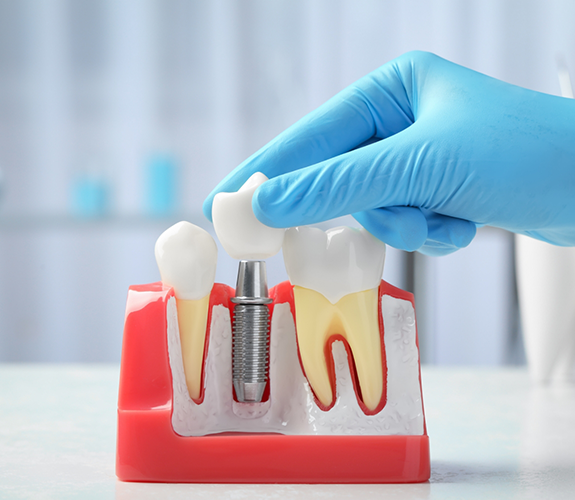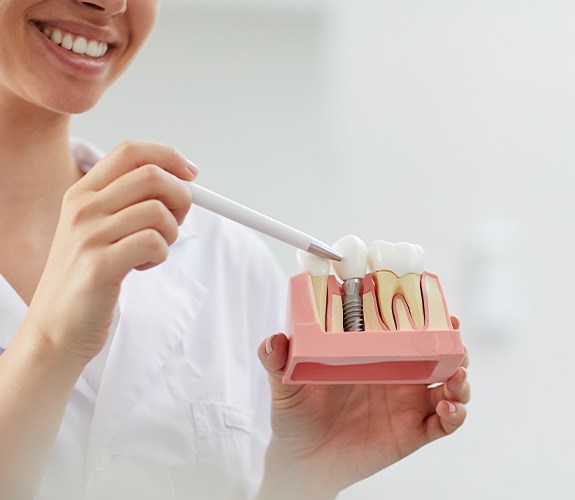Wondering if Dental Implants Are Right for You?
Take our quick quiz to find out if you’re a good candidate for dental implants and learn what your personalized treatment journey could look like.
If you need a more “permanent” fix for tooth loss, you won’t find a better option than dental implants. These posts represent the only root-to-crown replacement method on the market! In other words, they take a comprehensive approach that lets you enjoy a new smile for a lifetime. It’s to the point that modern dental implants in Boynton Beach stand a cut above the other restoration options. For more on these fixed prosthetics, please read onward or call us to book an appointment.

Dental implants don’t work like dentures and dental bridges do. Rather than sit above the gumline, these posts extend beneath the gums and fit within your jawbone. This design lets them fuse with nearby bone tissue to become permanent parts of your mouth. From there, they stimulate your jaw to prevent facial collapse while supporting your final restoration. They can even last a lifetime if you give them proper maintenance and care.

At your initial consultation, Dr. Rodriguez will custom tailor your dental implant treatment plan to meet your individual needs. In some cases, patients may require preliminary procedures like bone grafts or sinus lifts, and in others, the journey is simpler. However, every dental implant case that our team at Family Dentistry of Boynton Beach takes on has four main steps: the consultation, surgery, healing and abutment placement, and attaching the final restorations. You can learn more about each of these by reading below.

Did you know that dental implants continue to gain popularity, with an estimated 500,000 placed annually? Many experts consider them the ideal way to rebuild missing teeth because of their placement in your jaw. As a result, these restorations are more firmly rooted in your mouth and are usually stronger and more secure than dentures or dental bridges.
Because of this, dental implants provide unique advantages over the alternative solutions for tooth loss. Continue reading to learn more about how this treatment might benefit you!
Dental implants have a success rate of over 95%, which is quite impressive! The key to maintaining yours is proper care and maintenance. That starts with brushing, flossing, and rinsing with mouthwash consistently at home and extends to coming to our office every six months for a checkup and cleaning.
Important reminder: If you start to experience any warning signs of dental implant failure, like your restoration feels loose, call our Boynton Beach dental office right away. That way, Dr. Camilo Rodriguez can complete an exam, determine what the root of the problem is, and help you decide the best way to proceed.
Oftentimes, patients in their 60s, 70s, and 80s assume that they are too old for dental implants. However, candidacy is determined by factors like jawbone density and oral health, not age. So, if you are struggling with tooth loss and are interested in rebuilding your smile with dental implants in Boynton Beach, don’t let your age stop you from scheduling a consultation with us!
Smoking is often a disqualifier. However, there are some exceptions. So, don’t hesitate to schedule a dental implant consultation with us. During your visit, Dr. Camilo Rodriguez will discuss the risks and help you decide if this is the best tooth-replacement solution for you. Even if the answer is “yes,” you will need to refrain from using tobacco products both leading up to and after the procedure.
Yes! There are several reasons for this, including the fact that they are inserted directly into the jawbone, which means they won’t slip out of place unexpectedly. The restoration secured on top is also custom-made with your unique face shape, dental needs, and aesthetic goals in mind. So, you don’t have to worry – no unwanted attention will be drawn to your smile.
Since dental implants get their strength from your jawbone and only the best materials are used to make your restoration, there isn’t a long list of dietary restrictions that you need to abide by. With that said, there are some foods that increase your risk of dental damage, including peanut brittle, hard pretzels, and lollipops. So, it’s best to keep sugary and crunchy snacks like these to a minimum and stick to mostly healthy, smile-friendly foods, like cottage cheese, plain yogurt, and oatmeal.
Yes, dental implants can replace any of the teeth in your mouth, including your molars. If you are only missing one, then we can replace it with a single dental implant. If you are missing several, then we can secure a bridge or partial denture in place with several strategically placed dental implants instead.